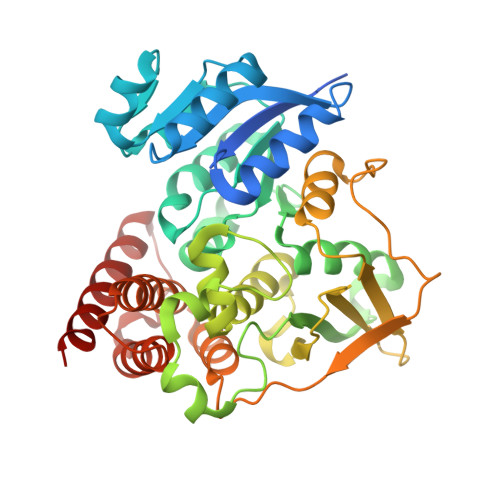Alteration of the Flexible Loop in 1-Deoxy-d-xylulose-5-phosphate Reductoisomerase Boosts Enthalpy-Driven Inhibition by Fosmidomycin.
Kholodar, S.A., Tombline, G., Liu, J., Tan, Z., Allen, C.L., Gulick, A.M., Murkin, A.S.(2014) Biochemistry 53: 3423-3431
- PubMed: 24825256
- DOI: https://doi.org/10.1021/bi5004074
- Primary Citation of Related Structures:
4OOE, 4OOF - PubMed Abstract:
1-Deoxy-d-xylulose-5-phosphate reductoisomerase (DXR), which catalyzes the first committed step in the 2-C-methyl-d-erythritol 4-phosphate pathway of isoprenoid biosynthesis used by Mycobacterium tuberculosis and other infectious microorganisms, is absent in humans and therefore an attractive drug target. Fosmidomycin is a nanomolar inhibitor of DXR, but despite great efforts, few analogues with comparable potency have been developed. DXR contains a strictly conserved residue, Trp203, within a flexible loop that closes over and interacts with the bound inhibitor. We report that while mutation to Ala or Gly abolishes activity, mutation to Phe and Tyr only modestly impacts kcat and Km. Moreover, pre-steady-state kinetics and primary deuterium kinetic isotope effects indicate that while turnover is largely limited by product release for the wild-type enzyme, chemistry is significantly more rate-limiting for W203F and W203Y. Surprisingly, these mutants are more sensitive to inhibition by fosmidomycin, resulting in Km/Ki ratios up to 19-fold higher than that of wild-type DXR. In agreement, isothermal titration calorimetry revealed that fosmidomycin binds up to 11-fold more tightly to these mutants. Most strikingly, mutation strongly tips the entropy-enthalpy balance of total binding energy from 50% to 75% and 91% enthalpy in W203F and W203Y, respectively. X-ray crystal structures suggest that these enthalpy differences may be linked to differences in hydrogen bond interactions involving a water network connecting fosmidomycin's phosphonate group to the protein. These results confirm the importance of the flexible loop, in particular Trp203, in ligand binding and suggest that improved inhibitor affinity may be obtained against the wild-type protein by introducing interactions with this loop and/or the surrounding structured water network.
Organizational Affiliation:
Department of Chemistry, University at Buffalo , Buffalo, New York 14260-3000, United States.

















